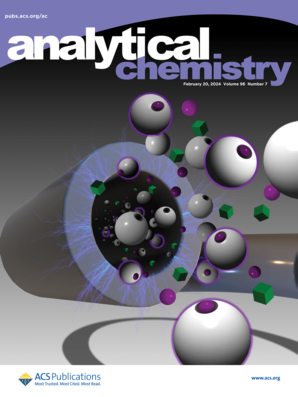Amino Acid-Regulated Biomimic Fe-MOF Nanozyme with Enhanced Activity and Specificity for Colorimetric Sensing of Uranyl Ions in Seawater
IF 6.7
1区 化学
Q1 CHEMISTRY, ANALYTICAL
引用次数: 0
Abstract
Nanozymes are attracting widespread attention as effective alternatives to overcome the limitations of natural enzymes. However, their catalytic performance is unsatisfactory due to the low catalytic activity and specificity. In this work, an efficient metal–organic framework (MOF) nanozyme mimicking the active centers of natural enzymes has been developed and its catalysis mechanism has been thoroughly investigated. The partial histidine- and arginine-doped Fe-MOF (HA Fe-MOF) is demonstrated to activate structure reconstruction with abundant oxygen vacancy generation, which promotes the binding capacity of HA Fe-MOF. The Fe sites in HA Fe-MOF act as catalytic sites for decomposition of H2O2. Intriguingly, histidine and arginine in the HA Fe-MOF can form hydrogen bonds with H2O2 as observed in natural enzymes, constituting a unique microenvironment that increases the local concentration of H2O2. Benefiting from the establishment of such enzyme-mimicking active centers, HA Fe-MOF exhibits high peroxidase-like specificity and activity. In addition, HA Fe-MOF holds great potential for detecting uranyl ions with a limit of detection as low as 0.012 μM, surpassing most reported nanozymes. This work achieves the rational design of highly specific peroxidase-like nanozymes by mimicking the structure–selectivity relationship of natural peroxidases, which provides new insights into the design of nanozymes with advanced configurations.

氨基酸调节的仿生Fe-MOF纳米酶对海水中铀酰离子的比色感应活性和特异性增强
纳米酶作为克服天然酶局限性的有效替代品受到广泛关注。然而,由于催化活性和特异性较低,它们的催化性能并不令人满意。本研究开发了一种模仿天然酶活性中心的高效金属有机框架(MOF)纳米酶,并对其催化机理进行了深入研究。部分组氨酸和精氨酸掺杂的 Fe-MOF(HA Fe-MOF)可激活结构重构,产生大量氧空位,从而提高 HA Fe-MOF 的结合能力。HA Fe-MOF 中的铁位点是分解 H2O2 的催化位点。耐人寻味的是,HA Fe-MOF 中的组氨酸和精氨酸能与 H2O2 形成氢键,就像在天然酶中观察到的那样,构成了一种能增加局部 H2O2 浓度的独特微环境。得益于这种仿酶活性中心的建立,HA Fe-MOF 表现出类似过氧化物酶的高度特异性和活性。此外,HA Fe-MOF 还具有检测铀酰离子的巨大潜力,其检测限低至 0.012 μM,超过了大多数已报道的纳米酶。这项工作通过模仿天然过氧化物酶的结构选择性关系,实现了高特异性过氧化物酶样纳米酶的合理设计,为设计具有先进构型的纳米酶提供了新的思路。
本文章由计算机程序翻译,如有差异,请以英文原文为准。
求助全文
约1分钟内获得全文
求助全文
来源期刊

Analytical Chemistry
化学-分析化学
CiteScore
12.10
自引率
12.20%
发文量
1949
审稿时长
1.4 months
期刊介绍:
Analytical Chemistry, a peer-reviewed research journal, focuses on disseminating new and original knowledge across all branches of analytical chemistry. Fundamental articles may explore general principles of chemical measurement science and need not directly address existing or potential analytical methodology. They can be entirely theoretical or report experimental results. Contributions may cover various phases of analytical operations, including sampling, bioanalysis, electrochemistry, mass spectrometry, microscale and nanoscale systems, environmental analysis, separations, spectroscopy, chemical reactions and selectivity, instrumentation, imaging, surface analysis, and data processing. Papers discussing known analytical methods should present a significant, original application of the method, a notable improvement, or results on an important analyte.
 求助内容:
求助内容: 应助结果提醒方式:
应助结果提醒方式:


